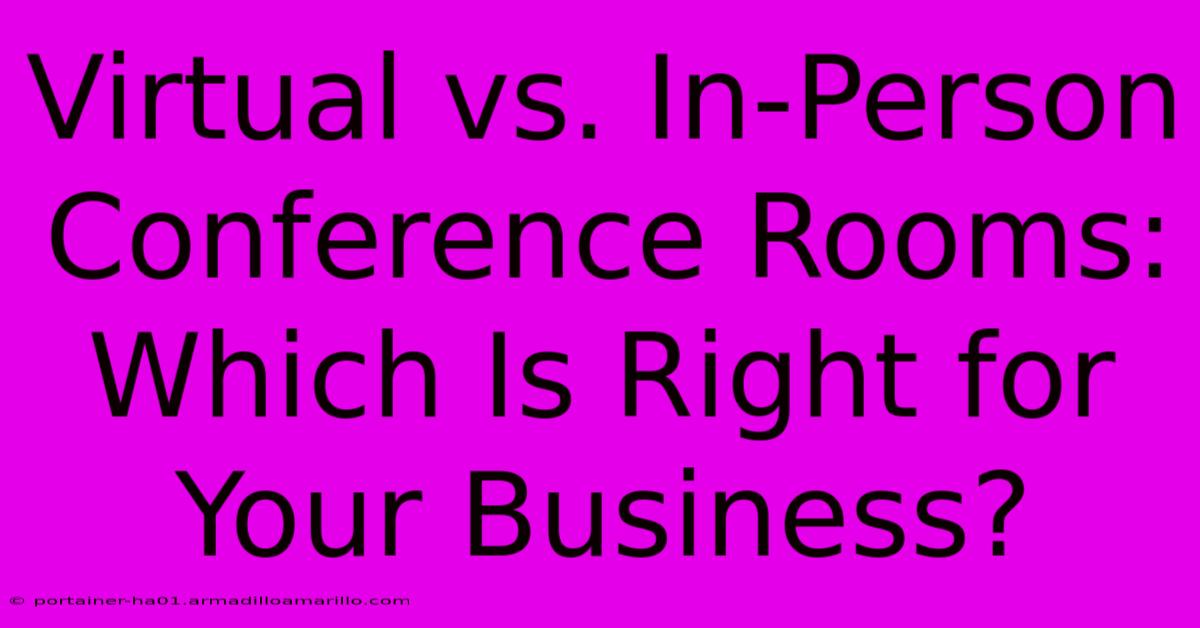Virtual Vs. In-Person Conference Rooms: Which Is Right For Your Business?

Table of Contents
Virtual vs. In-Person Conference Rooms: Which Is Right for Your Business?
The way we collaborate has changed dramatically. Gone are the days when a single, centrally located conference room sufficed. Today, businesses need to consider both virtual conference rooms and in-person conference rooms, each offering unique advantages and disadvantages. Choosing the right option – or even a hybrid approach – depends heavily on your specific business needs and priorities. This article will delve into the pros and cons of each, helping you make the best decision for your company.
In-Person Conference Rooms: The Tangible Touch
Traditional in-person conference rooms offer a tangible experience that many find irreplaceable. Let's explore their benefits:
Advantages of In-Person Meetings:
- Enhanced Collaboration and Brainstorming: The face-to-face interaction fosters a more spontaneous and creative exchange of ideas. Nonverbal cues, spontaneous discussions, and a shared physical space contribute to a richer collaborative experience.
- Stronger Team Building: In-person meetings provide opportunities for informal networking and relationship building, strengthening team cohesion and morale.
- Improved Communication Clarity: While miscommunication can still occur, the immediacy of in-person conversations reduces ambiguity and allows for quick clarifications.
- Confidentiality and Security: Sensitive discussions are better handled in a secure, controlled environment like a dedicated conference room, minimizing the risk of data breaches.
Disadvantages of In-Person Meetings:
- High Costs: Maintaining physical conference rooms involves significant costs, including rent, utilities, equipment maintenance, and travel expenses for attendees.
- Geographic Limitations: In-person meetings restrict participation to individuals who can physically attend, excluding remote employees or those located far from the office.
- Scheduling Challenges: Coordinating schedules across time zones and individual commitments can be time-consuming and frustrating.
- Environmental Impact: Frequent travel to in-person meetings contributes to a larger carbon footprint.
Virtual Conference Rooms: The Flexible Frontier
Virtual conference rooms, powered by video conferencing technology, have become increasingly sophisticated and prevalent. They offer a level of flexibility and accessibility that traditional rooms cannot match.
Advantages of Virtual Meetings:
- Cost-Effectiveness: Virtual meetings significantly reduce travel expenses, venue costs, and other related expenditures.
- Increased Accessibility: Participants can join from anywhere with an internet connection, enabling global collaboration and inclusivity for remote workers and geographically dispersed teams.
- Enhanced Flexibility: Scheduling is more flexible as participants don't need to travel or adhere to strict time constraints.
- Reduced Environmental Impact: Virtual meetings drastically reduce travel-related carbon emissions.
- Easy Recording and Sharing: Meetings can be easily recorded and shared with those who couldn't attend.
Disadvantages of Virtual Meetings:
- Technology Dependence: Reliance on technology means potential disruptions due to internet outages, software glitches, or technical difficulties.
- Reduced Engagement: Lack of face-to-face interaction can sometimes lead to reduced engagement and participation.
- Communication Challenges: Misunderstandings can arise more easily due to the lack of nonverbal cues and immediate feedback.
- Security Concerns: Protecting sensitive information during virtual meetings requires careful planning and the use of secure platforms.
Finding the Right Balance: Hybrid Approaches
For many businesses, the ideal solution lies in a hybrid approach, combining the strengths of both in-person and virtual conference rooms. This allows you to cater to different needs and preferences. For example, you might use virtual meetings for routine updates or large-scale presentations, while reserving in-person meetings for critical strategic planning sessions or team-building exercises.
Conclusion: The Best Choice for Your Business
The choice between virtual and in-person conference rooms hinges on your business's unique requirements. Consider factors like budget, team location, the nature of your meetings, the sensitivity of information shared, and your environmental impact goals. A careful analysis of these factors will help you determine the best solution – whether it's a primarily virtual setup, a traditional in-person approach, or a flexible hybrid model – to enhance collaboration, boost productivity, and achieve your business objectives.

Thank you for visiting our website wich cover about Virtual Vs. In-Person Conference Rooms: Which Is Right For Your Business?. We hope the information provided has been useful to you. Feel free to contact us if you have any questions or need further assistance. See you next time and dont miss to bookmark.
Featured Posts
-
The Ultimate Installation Guide Avoid Pitfalls And Maximize Efficiency
Feb 06, 2025
-
Ottimizza I Tuoi Caricamenti Online 5 Trucchi Da Professionisti Per Comprimere Le Immagini Rapidamente
Feb 06, 2025
-
Wireframing Wonder Unveiling The 9 Golden Examples For Portfolio Perfection
Feb 06, 2025
-
Master Wireframing Like A Pro 9 Examples That Show You The Way
Feb 06, 2025
-
Raider Nation Exposed Unmasking The Identity Of Raider Rush
Feb 06, 2025
